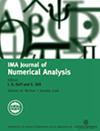ε-随机Allen–Cahn方程时空间断Galerkin方法的后验误差分析
IF 2.3
2区 数学
Q1 MATHEMATICS, APPLIED
引用次数: 0
摘要
在这项工作中,我们对Antonopoulou(2020)中提出的具有轻微噪声的$\varepsilon $依赖随机Allen-Cahn方程的时空不连续Galerkin格式进行了后测误差分析。李建军,李建军,李建军,等。具有噪声的$\varepsilon $依赖随机Allen-Cahn方程$\dot{W}^\varepsilon $趋近于$\varepsilon \rightarrow 0$。根据Funaki(1999)的最小正则性,随机反应-扩散方程的奇异极限和随机界面的生成,我们的结果是在低正则性下得到的,因为假设噪声在空间上均匀光滑,只是在时间上一次连续可微。数学学报。中国科学,15,407-438)。我们证明了一个后验误差估计的$m$维问题,$m\leq 4$对于一类一般的时空有限元空间。如果步长$h$以$\varepsilon $的正幂为界,则后验界仅在$\varepsilon ^{-1}$中多项式地增长。这与迄今为止对$\varepsilon $依赖的确定性Allen-Cahn或确定性和随机Cahn-Hilliard方程的连续有限元格式的先验误差分析所提出的限制一致。作为一个应用,我们研究了离散解由分离空间变量和时间变量的多项式函数近似的张量元素;其中的后验估计涉及维度,以及空间、时间离散参数。然后,我们考虑Weber(2010)在随机Allen-Cahn方程的短时间渐近中定义的轻微噪声$\dot{W}^\varepsilon $的特殊情况。安。亨利·庞加莱研究所。Stat., 46, 965-975),通过一个高斯过程的卷积和一个适当的缓和核,然后数值构造。最后,我们为数值算法提供了一些有用的见解,并首次给出了该方案在各种感兴趣的情况下的一维和二维问题的数值实验,并与确定性问题进行了比较。本文章由计算机程序翻译,如有差异,请以英文原文为准。
A posteriori error analysis of space-time discontinuous Galerkin methods for the ε-stochastic Allen–Cahn equation
In this work, we apply an a posteriori error analysis for the space-time, discontinuous in time, Galerkin scheme, which has been proposed in Antonopoulou (2020, Space-time discontinuous Galerkin methods for the $\varepsilon $-dependent stochastic Allen–Cahn equation with mild noise. IMA J. Num. Analysis, 40, 2076–2105) for the $\varepsilon $-dependent stochastic Allen–Cahn equation with mild noise $\dot{W}^\varepsilon $ tending to rough as $\varepsilon \rightarrow 0$. Our results are derived under low regularity since the noise even smooth in space is assumed only one-time continuously differentiable in time, according to the minimum regularity properties of Funaki (1999, Singular limit for stochastic reaction–diffusion equation and generation of random interfaces. Acta Math. Sinica, 15, 407–438). We prove a posteriori error estimates for the $m$-dimensional problem, $m\leq 4$ for a general class of space-time finite element spaces. The a posteriori bound is growing only polynomially in $\varepsilon ^{-1}$ if the step length $h$ is bounded by a positive power of $\varepsilon $. This agrees with the restriction posed so far in the a priori error analysis of continuous finite element schemes for the $\varepsilon $-dependent deterministic Allen–Cahn or deterministic and stochastic Cahn–Hilliard equation. As an application, we examine tensorial elements where the discrete solution is approximated by polynomial functions of separated space and time variables; the a posteriori estimates there involve dimensions, and the space, time discretization parameters. We then consider the special case of the mild noise $\dot{W}^\varepsilon $ as defined in Weber (2010, On the short time asymptotic of the stochastic Allen–Cahn equation. Ann. Inst. Henri Poincare Probab. Stat., 46, 965–975) through the convolution of a Gaussian process with a proper mollifying kernel, which is then numerically constructed. Finally, we provide some useful insights for the numerical algorithm, and present for the first time some numerical experiments of the scheme for both one- and two-dimensional problems in various cases of interest, and compare with the deterministic ones.
求助全文
通过发布文献求助,成功后即可免费获取论文全文。
去求助
来源期刊
CiteScore
5.30
自引率
4.80%
发文量
79
审稿时长
6-12 weeks
期刊介绍:
The IMA Journal of Numerical Analysis (IMAJNA) publishes original contributions to all fields of numerical analysis; articles will be accepted which treat the theory, development or use of practical algorithms and interactions between these aspects. Occasional survey articles are also published.

 求助内容:
求助内容: 应助结果提醒方式:
应助结果提醒方式:


